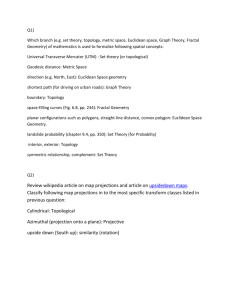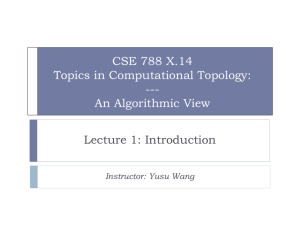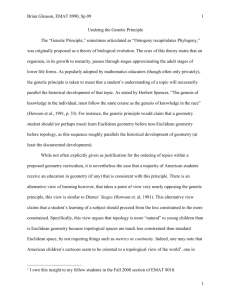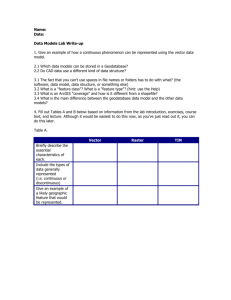Computational Topology
advertisement
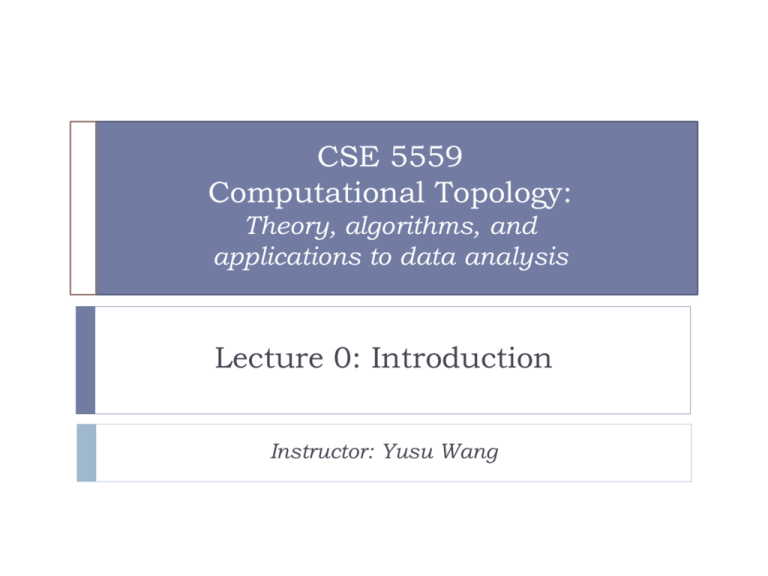
CSE 5559 Computational Topology: Theory, algorithms, and applications to data analysis Lecture 0: Introduction Instructor: Yusu Wang Lecture 0: Introduction What is topology Why should we be interested in it What to expect from this course Space and Shape Geometry All about distances and angles area, volume, curvatures, etc Euclidean geometry Riemannian geometry Hyperbolic geometry … Motivating Examples I Graphics Texture mapping Continuous deformation Motivating Examples I Graphics Texture mapping Continuous deformation Motivating Examples II Computer Vision Clustering Shape space Courtesy of Carlsson et al, On the local behavior of spaces of natural images Motivating Examples III Sensor networks: Hole detection Routing / load balancing Courtesy of Wang et al. Boundary recognition in sensor networks by topological methods Courtesy of Sarkar et al., Covering space for in-network sensor data storage Motivating Examples IV Structural biology Motif identification Energy landscape [Wolynes et al., Folding and Design 1996] Topology Detailed geometric information not sufficient Or not necessary Or may even be harmful Wish to identify key information, “qualitative” structure Topology Connectivity Introduction In general, topology Coarser yet essential information Characterization, feature identification General, powerful tools for both space and functions defined on a space Elegant mathematical understanding available However Difficult mathematical language This Course Introduce basics and recent developments in computational topology Goal: From an algorithmic and computational perspective Understand basic language in computational topology Appreciate the power of topological methods Potentially apply topological methods to your research www.cse.ohio-state.edu/~yusu/courses/5559 References Computational Topology: An Introduction, by H. Edelsbrunner and J. Harer, AMS Press, 2009. Online course notes by Herbert Edelsbrunner on computational topology Algebraic Topology, by A. Hatcher, Cambridge University Press, 2002. (Online version available) An Introduction to Morse Theory, by Y. Matsumoto, Amer. Math. Soc., Providence, Rhode Island, 2002. Elements of Algebraic Topology, by J. R. Munkres, Perseus, Cambridge, Massachusetts, 1984. Course notes Course Format Grading: Course project / survey: 90% Include every stage of it Class participation: 10% Some timelines: Week 3-4: Week 6-7: Meet me to explain your background, and your potential interests Choose project / survey topics Week 8 – 15: Final project / survey. Presentation. Introduction to Topology History Seven Bridges of Königsberg Euler cycle problem Abstraction of connectivity Topology: “ qualitative geometry from the ordinary geometry in which quantitative relations chiefly are treated ” Homeomorphism Connectivity Intuitively, two spaces have the same topology if one can continuously deform one to the other without breaking, gluing, and inserting new things open curve closed curve self-intersecting curve Two spaces with the same topology are homeomorphic Trefoil knot Relaxation of Homeomorphism Homotopy equivalent Homologous Topological Quantities Homeomorphism —› homotopy equivalence —› homology Describe the qualitative structure of input space at different levels Quantities invariant under them (topological quantities) => (Essential) features Make topologic objects powerful for feature identification and characterization This course will give Definition, intuition, and their computation Also examples of applications Topological objects Not just features of space, one can also incorporate geometry, also functions or maps of a space to capture more sophisticated features Topological objects Not just features of space, one can also incorporate geometry, also functions or maps of a space to capture more sophisticated features Topological objects Not just features of space, one can also incorporate geometry, also functions or maps of a space to capture more sophisticated features Topological objects Not just features of space, one can also incorporate geometry, also functions or maps of a space to capture more sophisticated features Topological objects Not just features of space, one can also incorporate geometry, also functions or maps of a space to capture more sophisticated features Topological objects Not just features of space, one can also incorporate geometry, also functions or maps of a space to capture more sophisticated features Death time Birth time Topological objects Not just features of space, one can also incorporate geometry, also functions or maps of a space to capture more sophisticated features Topological objects Not just features of space, one can also incorporate geometry, also functions or maps of a space to capture more sophisticated features Topological objects Not just features of space, one can also incorporate geometry, also functions or maps of a space to capture more sophisticated features Topological objects Not just features of space, one can also incorporate geometry, also functions or maps of a space to capture more sophisticated features Topological objects Not just features of space, one can also incorporate geometry, also functions or maps of a space to capture more sophisticated features Topological objects Not just features of space, one can also incorporate geometry, also functions or maps of a space to capture more sophisticated features Topological objects Not just features of space, one can also incorporate geometry, also functions or maps of a space to capture more sophisticated features Topological objects Not just features of space, one can also incorporate geometry, also functions or maps of a space to capture more sophisticated features To summarize Topological concepts Topological objects / methods Captures coarse yet essential information about data, space, or functions Are powerful due to their generality Are flexible, can describe geometric information or any other information of interests (modeled as functions / maps) They form natural tools for Feature identification, characterization of space / data Topics Basics in Topology Common complexes Homology Persistence Homology inference from Data Scalar field analysis Reeb graph / contour tree Hierarchical clustering Mapper and multiscale-mapper Will focus on not only concepts, definitions, algorithms, also intuition why they work, and how they can be used. Data sparsification Issue of noise Or (discrete) Morse theory


